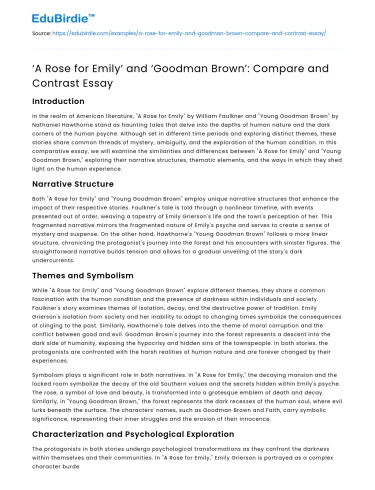Introduction
In the realm of American literature, "A Rose for Emily" by William Faulkner and "Young Goodman Brown" by Nathaniel Hawthorne stand as haunting tales that delve into the depths of human nature and the dark corners of the human psyche. Although set in different time periods and exploring distinct themes, these stories share common threads of mystery, ambiguity, and the exploration of the human condition. In this comparative essay, we will examine the similarities and differences between "A Rose for Emily" and "Young Goodman Brown," exploring their narrative structures, thematic elements, and the ways in which they shed light on the human experience.
Narrative Structure
Both "A Rose for Emily" and "Young Goodman Brown" employ unique narrative structures that enhance the impact of their respective stories. Faulkner's tale is told through a nonlinear timeline, with events presented out of order, weaving a tapestry of Emily Grierson's life and the town's perception of her. This fragmented narrative mirrors the fragmented nature of Emily's psyche and serves to create a sense of mystery and suspense. On the other hand, Hawthorne's "Young Goodman Brown" follows a more linear structure, chronicling the protagonist's journey into the forest and his encounters with sinister figures. The straightforward narrative builds tension and allows for a gradual unveiling of the story's dark undercurrents.
Save your time!
We can take care of your essay
- Proper editing and formatting
- Free revision, title page, and bibliography
- Flexible prices and money-back guarantee
Themes and Symbolism
While "A Rose for Emily" and "Young Goodman Brown" explore different themes, they share a common fascination with the human condition and the presence of darkness within individuals and society. Faulkner's story examines themes of isolation, decay, and the destructive power of tradition. Emily Grierson's isolation from society and her inability to adapt to changing times symbolize the consequences of clinging to the past. Similarly, Hawthorne's tale delves into the theme of moral corruption and the conflict between good and evil. Goodman Brown's journey into the forest represents a descent into the dark side of humanity, exposing the hypocrisy and hidden sins of the townspeople. In both stories, the protagonists are confronted with the harsh realities of human nature and are forever changed by their experiences.
Symbolism plays a significant role in both narratives. In "A Rose for Emily," the decaying mansion and the locked room symbolize the decay of the old Southern values and the secrets hidden within Emily's psyche. The rose, a symbol of love and beauty, is transformed into a grotesque emblem of death and decay. Similarly, in "Young Goodman Brown," the forest represents the dark recesses of the human soul, where evil lurks beneath the surface. The characters' names, such as Goodman Brown and Faith, carry symbolic significance, representing their inner struggles and the erosion of their innocence.
Characterization and Psychological Exploration
The protagonists in both stories undergo psychological transformations as they confront the darkness within themselves and their communities. In "A Rose for Emily," Emily Grierson is portrayed as a complex character burdened by the weight of tradition and the ghosts of her past. Her descent into madness and the shocking revelation of her secret highlight the psychological complexities of her character. In "Young Goodman Brown," Goodman Brown grapples with his faith and the realization that even those he holds dear are capable of evil. The internal conflicts faced by both characters shed light on the duality of human nature and the potential for darkness within us all.
Conclusion
In conclusion, "A Rose for Emily" and "Young Goodman Brown" offer profound explorations of the human condition and the presence of darkness in our lives. While Faulkner's story focuses on isolation, decay, and the consequences of clinging to the past, Hawthorne's tale delves into moral corruption and the conflict between good and evil. Through their narrative structures, thematic elements, and characterizations, both stories illuminate the complexities of human nature and the enduring power of dark storytelling in American literature.






 Stuck on your essay?
Stuck on your essay?

